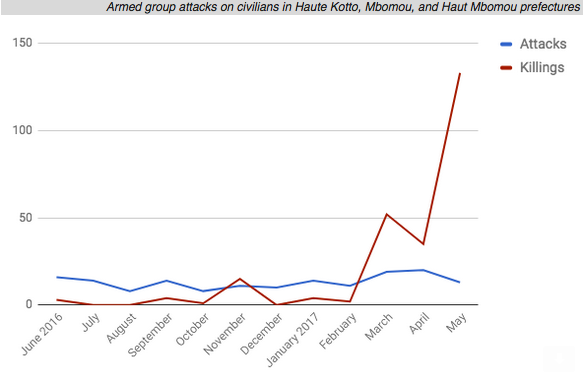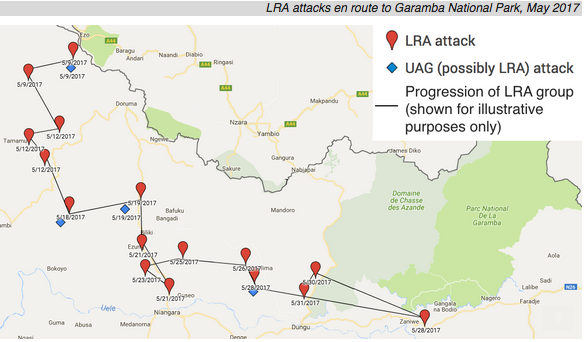A Lord’s Resistance Army (LRA) group crossed the border from Central African Republic (CAR) into northern Democratic Republic of Congo (DRC) in May 2017, abducting at least 23 people in a series of attacks on civilians en route to Garamba National Park. In eastern CAR, violence by armed groups against civilians escalated dramatically in May, with ex-Seleka factions and local “self-defense” (anti-balaka) groups killing 132 civilians in the prefectures of Haute Kotto, Mbomou, and Haut Mbomou. Anti-balaka groups also killed six peacekeepers from the United Nations Multidimensional Integrated Stabilization Mission in the CAR (MINUSCA), making it the deadliest month for the mission since it began in 2014.
For further analysis on armed group activity in eastern CAR, as well as neighboring regions of DRC and South Sudan, see Invisible Children’s recent report, Escalating Violence in Eastern CAR Poses Grave Threat to Civilians.

LRA fighters attack civilians en route to Garamba National Park
Since 2012, LRA leader Joseph Kony has frequently tasked commanders with traveling to DRC’s Garamba National Park and surrounding hunting reserves to poach elephants and then return to eastern CAR and the Sudanese-controlled Kafia Kingi territory with illicit ivory. The presence of LRA poaching groups in Garamba has been directly correlated with increased attacks on communities surrounding the protected area, during which LRA forces loot food and other supplies to sustain themselves as they poach. Before 2017, the last period of LRA activity in and near Garamba was from April–July 2016.
On May 9, LRA forces attacked two locations in DRC’s Haut Uele province just south of the border with CAR. Over the next three weeks, a series of LRA attacks indicated the progression of an LRA group (or groups) from the border area towards Garamba. Several other attacks in Haut Uele during May, attributed to unidentified armed groups due to the limited availability of information on the perpetrator, may have also been committed by these LRA forces. LRA attacks on communities near Garamba have continued into June, with four attacks east and south of the park. In total, LRA forces have committed at least 14 attacks and abducted at least 33 civilians in Haut Uele since the beginning of May.

Escalating violence by ex-Seleka and anti-balaka groups in eastern CAR
Attacks on civilians have increased dramatically so far in 2017 in CAR’s Haute Kotto and Mbomou prefectures, primarily due to fighting involving anti-balaka militias and two ex-Seleka factions, the Front Populaire pour la Renaissance de la Centrafrique (FPRC) and the Union pour la Paix en Centrafrique (UPC). On May 12, anti-balaka fighters attacked Bangassou, the capital of Mbomou prefecture, where they deliberately targeted the predominantly Muslim neighborhood of Tokoyo. More than 115 civilians were killed in the ensuing fighting. The incident escalated sectarian tension across the region, and days later ex-Seleka and anti-balaka fighters clashed in Bria, the capital of Haute Kotto prefecture. At least 17 civilians were killed in the fighting, which also resulted in the looting of several humanitarian compounds and the displacement of at least 20,000 people.
Anti-balaka groups also targeted MINUSCA peacekeepers on several occasions in May 2017. On May 8, fighters ambushed a MINUSCA convoy east of Bangassou, near the community of Yongofongo, killing five peacekeepers and injuring ten others. During the May 12 attack on Bangassou, some anti-balaka fighters targeted MINUSCA positions as others attacked the neighborhood of Tokoyo. One Moroccan peacekeeper was killed during the incident. In addition to the six peacekeepers killed in May, unidentified gunmen killed two Moroccan peacekeepers east of Obo on January 3, 2017.

Programmatic Updates
In DRC’s Haut Uele province, our team and community partners carried out a training on wildlife protection for community leaders in four communities, where they discussed pathways towards alternative livelihoods to hunting and the importance of wildlife protection and conservation in and near Garamba National Park.
In CAR, Invisible Children supported the transfer to Obo of a 10-year-old Congolese boy who escaped from the LRA in Mboki after three years in captivity. Invisible Children staff worked with AFASVR, one of our community partners in Obo, to ensure he was welcomed at their transit center. He will be cared for at the transit center until his family can be traced and he can return home. In May, our Invisible Children team in CAR also participated in a refresher training focused on the reporting of information related to sexual and gender-based violence (SGBV) and child protection abuses.
On May 30, MINUSCA and the UN Human Rights Office released a report documenting human rights abuses in CAR from 2003–2015. The report extensively cites data on armed group activity from Invisible Children’s LRA Crisis Tracker, particularly regarding LRA violence.
Think people should hear about this?